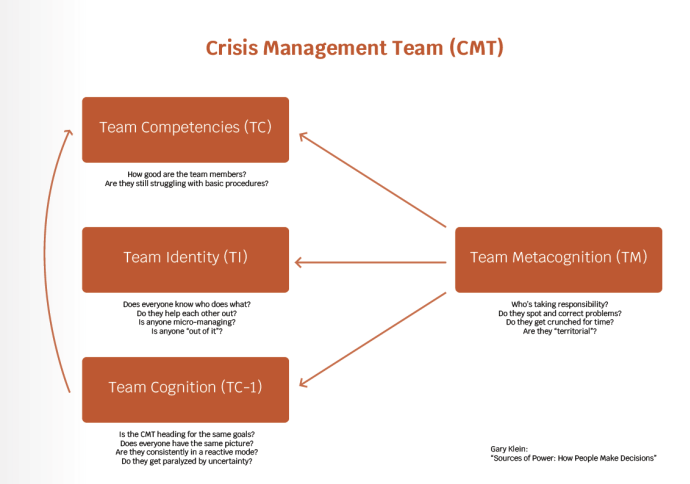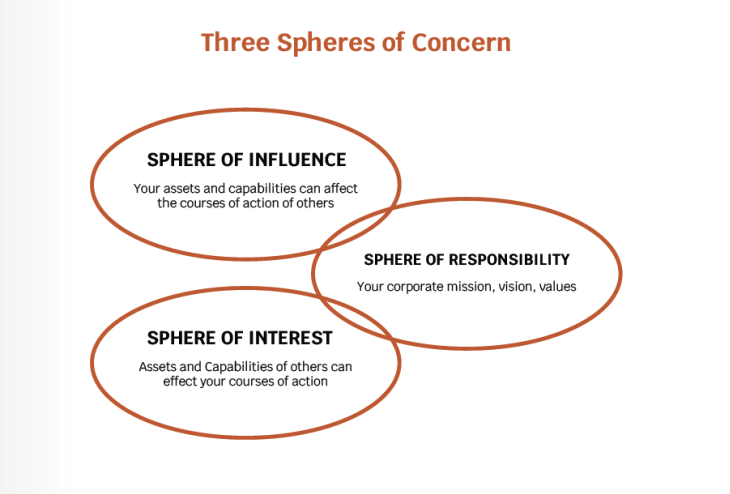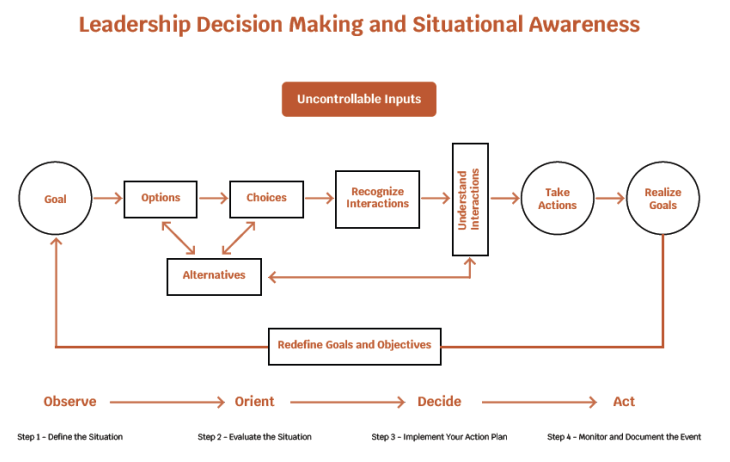Building a sustainable Crisis Management Team (CMT) requires effective decision analysis capability. You need: people, tools, and structure.
What does this mean? It means that the CMT must possess:
- Common mindset – To accomplish this the CMT has to have a common terminology that is understood by all members and they have to understand that the decision-making process in a crisis is different from normal day-to-day decision making.
- Training – Critical to becoming an effective CMT is training, this includes classroom, virtual, and other forms of knowledge infusion. In addition to training, effective simulations (tabletops, drills, exercises) should be regularly scheduled and conducted.
- Recognition of Weaknesses, Hazards, Opportunities, Threats, Strengths, Underlying Plans (WHOTSUP) – Effective baseline assessments that underpin the development of plans should be regularly performed. Risks, threats, hazards, and vulnerabilities are not static; each action taken to buffer against the effects of realization means that the risk, threat, hazard, and vulnerability changes and must be reassessed, buffered, and monitored.
- Active Analysis – Situational Awareness – Communication – Constant, rigorous analysis, awareness, and effective communication are necessary for the CMT to activate, and transform into crisis mode operations to effectively transition into recovery and return to business operations.
- Focused efforts that build credibility – Today much scrutiny occurs when a crisis erupts, media, stakeholders, regulators, and others will all be watching what the CMT does or does not do. Reputation Management has become a critical component of CMT operations.
- Flexible structure that supports long-term functional needs – Incident Command Systems, National Incident Management System, and other forms of structure for CMT operations are critical to understanding and adapting to your organization’s normal operating structure. Transition to crisis operations can be seamless or chaotic; seamless as a result of having a structure that adapts rapidly to evolving situations or chaotic with no clear direction and structure.

The figure below, a reference to Gary Klein’s book “Sources of Power: How People Make Decisions”, provides an example of some of the key questions that must be answered to form an effective CMT.
Team competencies, team identity, and team cognition create the framework for an effective CMT. Can your organization’s CMT answer the questions posited below? If not, perhaps a reconfiguration or restructuring may be in order?
Klein points out two challenges and one explanation for CMTs. He states that your biggest challenge will be:
- Getting the team to work together when they generally do not function every day as a CMT. Your next biggest challenge:
- Getting the team to comprehend their crisis management roles, responsibilities, functions, and how they differ from their day-to-day roles, responsibilities, and functions.
Klein gives five reasons why Crisis Management Teams fail:
- Crisis Management Team does not know its own reaction time – Think about how long it takes your CMT to react and begin to function in Crisis Mode.
- Communications – The failure to communicate effectively during the initial stages of a crisis and ongoing communication issues lead to more disruptions, delays, and misappropriation of resources. Common terminology and effective communication techniques must become a way of doing things versus an adjunct to CMT activities.
- Micro-Managing – If you are not on the scene do not attempt to tell the on-scene (Local Incident Commander) how to conduct tactical operations. You do not know what is going on, so rather than micromanage, ensure support is provided to the incident location.
- Decisions are left at low levels – Ensure that decisions are made at the appropriate levels. All too often a decision left at a lower level is going to be secondguessed. Additionally, the decision-maker at the lower level may not be aware of the effect of their decision as it ripples through the organization creating a tsunami of cascading effects.
- Allowing problems to compound – Not addressing problems early on can lead to greater disruptions through cascading effects and the creation of collateral damage that could be prevented.

Six Leadership Habits
1. Anticipate
Most of the focus at most organizations is on what is directly ahead. The leaders lack “peripheral vision”. This can leave your organization vulnerable to rivals who detect and act on ambiguous signals. To anticipate well, you must:
- Look for game-changing information at the periphery of your industry
- Search beyond the current boundaries of your business
- Build wide external networks to help you scan the horizon better
2. Think Critically
“Conventional wisdom” opens you to fewer raised eyebrows and second-guessing. But if you swallow every management fad, herd-like belief, and safe opinion at face value, your company loses all competitive advantage. Critical thinkers question everything. To master this skill, you must force yourself to:
- Reframe problems to get to the bottom of things, in terms of root causes
- Challenge current beliefs and mindsets, including your own
- Uncover hypocrisy, manipulation, and bias in organizational decisions
3. Interpret
Ambiguity is unsettling. Faced with it, the temptation is to reach for a fast (and potentially wrongheaded) solution. A good strategic leader holds steady, synthesizing information from many sources before developing a viewpoint. To get good at this, you have to:
- Seek patterns in multiple sources of data
- Encourage others to do the same
- Question prevailing assumptions and test multiple hypotheses simultaneously

4. Decide
Many leaders fall prey to “analysis paralysis”. You have to develop processes and enforce them, so that you arrive at a “good enough” position. To do that well, you have to:
- Carefully frame the decision to get to the crux of the matter
- Balance speed, rigor, quality, and agility. Leave perfection to higher powers
- Take a stand even with incomplete information and amid diverse views
5. Align
Total consensus is rare. A strategic leader must foster open dialogue, build trust, and engage key stakeholders, especially when views diverge. To pull that off, you need to:
- Understand what drives other people’s agendas, including what remains hidden
- Bring tough issues to the surface, even when it is uncomfortable
- Assess risk tolerance and follow through to build the necessary support
6. Learn
As your CMT grows, honest feedback is harder and harder to come by. You have to do what you can to keep it coming. This is crucial because success and letdown – especially letdown – are valuable sources of organizational learning. Here is what you need to do:
- Encourage and exemplify honest, rigorous debriefs to extract lessons
- Shift course quickly if you realize you are off track
- Celebrate both success and (well-intentioned) letdowns that provide insight
The figure below depicts the Three Spheres of Concern that CMTs have to recognize, adapt to, and manage. Your Sphere of Influence is what you bring to the table so to speak – it is the assets and capabilities that can affect the actions of others.

Your Sphere of Interest relates to those assets and capabilities that others possess which can influence your courses of action. Think of internal departments that you have no control over, but that can influence your actions. Recognize that external entities, similar to local, state, and federal government can have a major impact on your carefully laid out plans as well.
Your Sphere of Responsibility relates to your organization’s mission, vision, and values. Today, with so much emphasis on reputation, stakeholder management, and the everpresent effect of social media; your sphere of responsibility truly puts your CMT in the spotlight when a crisis occurs.
Expectations – Agenda – Focus
The length of time the enterprise will have to react to an event is directly related to the event’s perceived impact on the enterprise by its key stakeholders. Three levels of management must be joined into a seamless flow of information, decision making, and action. These are:
Tactical:
- Near Real-time
- Event-driven
- Results Oriented
- Based on the Plan
Operational:
- Support to Tactical Response and advising the Strategic Component
- Assessment Driven – Affected and Non-Affected Operations
- Cascade and Collateral Damage Prevention Oriented
- Based on Response Actions
Strategic:
- Broad-based – Stakeholder focused
- Issues Driven
- Results Oriented
- Based on Response and Operational Actions
The OODA Loop
The OODA Loop is the cycle observe-orient-decideact, developed by United States Air Force Colonel, John Boyd. Boyd applied the concept to the combat operations process, often at the operational level during military campaigns. It is now also often applied to understand commercial operations and learning processes. The approach explains how agility can overcome raw power in dealing with human opponents. It is especially applicable to cybersecurity and cyberwarfare.
The figure below is a depiction of the OODA Loop applied to decision-making in a crisis. The CMT can benefit greatly by incorporating this decision-making tool into its playbook.

Critical Functions
I have found that the following breakdown of functions can be organized by the CMT to provide structure and understanding of role responsibility for members of the CMT.I breakdown and apply the Incident Command System and National Incident Management System structures into eight areas for CMTs:
- Management – Defines who is in charge and what responsibilities are allocated at the tactical, operational, and strategic levels for decision making and management of the CMT.
- Planning – Short-term immediate needs and longterm needs, planning is essential.
- Operations – What is affected and what is currently not affected? How do you keep the event from cascading and creating collateral damage? Think vertically and horizontally.
- Infrastructure – Internal (what you control) and external (what you do not control). Information Security and Information Technology operations.
- Logistics – Current needs and extended-period needs. Think food, water, lodging, transportation, etc.
- Finance – Tracking costs associated with the crisis and expediting any services that are required to respond to the situation and for recovery efforts.
- Administration – All administrative tracking for Human Resources, records, privacy, and regulatory compliance issues.
- External Relations – All levels of government, stakeholders, media, “value chain”, etc. Who is the designated spokesperson at the tactical level, operational level, and strategic level? What is the message that you want to convey?
Concluding thoughts
Will your organization have an effective crisis management team or will it fragment and chaos ensue during a crisis? Crisis Management Teams must be able to deal with the “stress of the moment” and come together in a seamless fashion to be effective.









